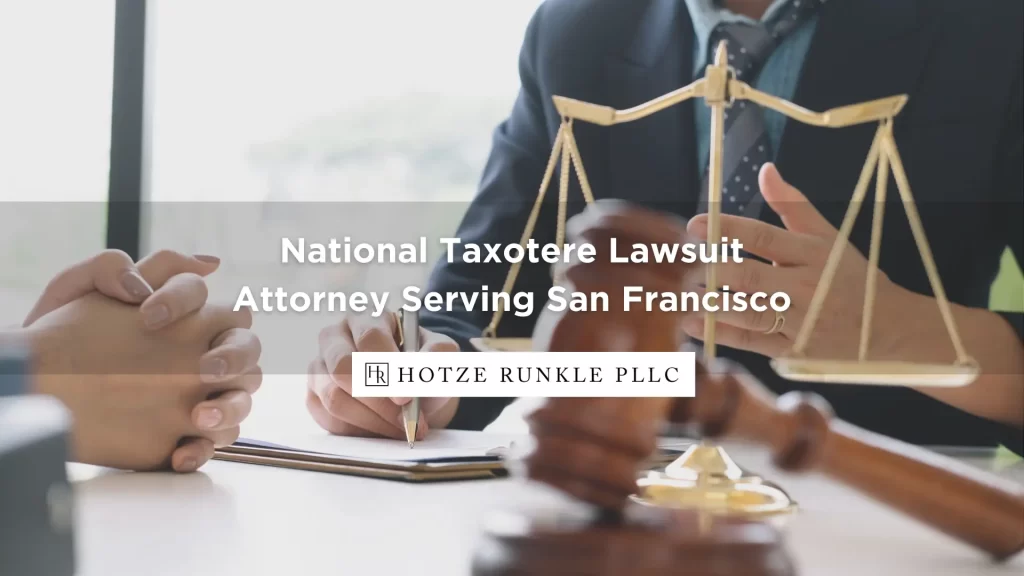
Were you diagnosed with canalicular stenosis? Did you receive the diagnosis after undergoing Taxotere chemotherapy? If so, Hotze Runkle PLLC might be able to help you pursue financial compensation for your suffering. It turns out the drug you used to treat your cancer can cause harmful side effects, including a permanent eye condition.
Medical researchers discovered a link between the chemo drug, Taxotere, and a serious eye condition called canalicular stenosis. When a person’s tears come in contact with Taxotere, the canaliculus – which is responsible for funneling tears – may become inflamed and infected, and this inflammation could eventually turn into canalicular stenosis, a permanent disorder marked by excessive tearing.
Canalicular stenosis can impact an individual’s quality of life, making it difficult to read, drive, watch television, and even socialize. Taxotere’s manufacturer, Sanofi-Aventis, failed to warn patients and doctors about their drug’s serious side effects, and they should be held accountable for their negligence.
Hotze Runkle PLLC has the resources and experience to hold Sanofi-Aventis responsible for their actions and secure the compensation that victims deserve. If you’re suffering from serious side effects after taking Taxotere, take our Quiz to determine next steps.
The Development of Canalicular Stenosis from Taxotere
Sanofi-Aventis is a pharmaceutical company that first manufactured Taxotere for cancer patients. The chemotherapy drug is used to stop cancer cells from growing and spreading in the body. Various cancers respond well to the treatment, but breast cancer is the type of cancer most commonly treated with Taxotere.
Unfortunately, an irritating side effect may develop while the patient is undergoing chemotherapy. Epiphora, or excessive eye-watering, is usually the first sign that the patient may be at risk of developing canalicular stenosis.
Studies have shown that Taxotere secretions interact with tears as they funnel through the tear ducts into the canaliculus of the ocular cavity. When that happens, it results in inflammation, and that inflammation can lead to a blockage of the canaliculus, which causes teary eyes.
Without early medical intervention, epiphora can lead to a diagnosis of canalicular stenosis, which is the narrowing or closing of the canaliculus. This eye condition is irreversible, so treatment is essential the second you start noticing any symptoms. Following are some of the ocular symptoms that cancer patients may develop during or following their Taxotere chemotherapy treatment:
- Excessive eye watering
- Headaches
- Dry eyes
- Blurry vision
- Eye infections
- Light sensitivity
- Eyelid swelling
- Clouding of the eye lens
- Central vision loss
If you don’t seek medical treatment when your watery eye symptom begins, the canaliculi could eventually close and prevent your tears from funneling through the tear ducts into your nasal cavity. Once they close, your eyes won’t function normally, and your tears won’t have anywhere to go except out of your eyes and onto your cheeks.
What Are the Treatment Options for Canalicular Stenosis?
Unfortunately, canalicular stenosis is a permanent medical condition with no known cure. It’s possible to manage symptoms, but you may require a medical procedure, which is expensive and invasive. During DCR, dacryocystorhinostomy, the surgeon cuts a hole in a bone or places a stent to create a new tunnel for tears to bypass the obstructed canaliculus.
If successful, it can effectively manage the symptoms of canalicular stenosis; however, it does come with some risks, such as:
- Blindness
- Uncontrollable bleeding
- Displaced or rejected stent
- Facial scarring
- Infection
- Abnormally fused tissue
- Tissue damage
If your condition becomes too severe for DCR, you may need to undergo CDCR. Conjuctivodacryocystorhinostomy is only necessary if one or both canaliculi become completely blocked, and there are no ocular structures that can create a new passageway for tears to flow. This procedure comes with the same risks as DCR and could help with the symptoms of canalicular stenosis.
Who Can I File a Lawsuit Against?
The drug company Sanofi-Aventis failed to initially warn consumers and physicians about the harmful side effects of Taxotere. It wasn’t until 2014 that they finally released warning labels that their drug could lead to serious complications for cancer patients undergoing chemotherapy. An employee who used to work at Sanofi-Aventis also accused them of paying doctors to prescribe their drug to patients for unapproved uses.
Anyone considering going up against a large corporation feels overwhelmed about the battle ahead of them. That’s why it’s crucial that you hire one of our Taxotere canalicular stenosis lawsuit attorneys. We’ll protect your rights and help you get through the stressful legal process. You can count on us to stay by your side from start to finish of your case and advise your options.
We believe in standing up to big pharma and holding careless parties responsible for their actions. Pharmaceutical companies are supposed to manufacture safe drugs. If side effects are possible, they have to release warning labels, so their consumers know about their drug’s risks. You likely have the right to pursue compensation from Sanofi-Aventis for the canalicular stenosis symptoms you developed.
Do I Need a Lawyer to Help Me With My Lawsuit?
When injured victims attempt to file a lawsuit without legal representation, they typically end up with less compensation than they deserve. They think the cost of a lawyer might not be worth it. However, filing a lawsuit is complicated and requires following a specific procedure and strict deadlines. The Taxotere canalicular stenosis lawsuit attorneys from Hotze Runkle PLLC will handle each step on your behalf to ensure everything goes smoothly.
Defense attorneys for pharmaceutical companies have endless resources at their disposal and the experience to go up against anyone in a lawsuit. If you’re unfamiliar with the process, they will take advantage of that and try to intimidate you into settling for less than you deserve.
We won’t let anyone take advantage of you and will ensure everyone treats you fairly. During a lawsuit, there are deadlines to adhere to and evidence to submit. We know how to request relevant documentation and stay on track, so your case doesn’t get dismissed by the courts. When you hire us, we’ll work efficiently and attempt to recover the maximum financial award possible.
How Much Is My Case Worth?
Our attorneys won’t be able to provide an exact number. However, there are different factors we’ll review to determine the compensation you deserve to receive from Sanofi-Aventis. We’ll present those same factors to the jury, so they understand all the facts of the case.
The various details that could contribute to your final monetary award include:
- The extent of your eye condition
- The treatment required to manage your symptoms
- If DCR or CDCR was a necessary procedure
- Visible or debilitating side effects that prevent you from completing routine tasks
- Duration of medical care
- Amount of evidence available proving your injury and the treatment you needed
- Statements from witnesses who saw your struggles
- Total damages incurred
- Physical impairment or disability resulting from the diagnosis of canalicular stenosis
A jury will also look at your damages to decide how much money you need to cover your expenses and your losses. Compensatory damages are the expenses and intangible losses an injured party incurs as the result of an accident or injury. Compensatory damages fall under two categories: economic and non-economic.
Your compensatory damages may include:
- Medical treatment: Bills from the hospital, physicians, imaging tests, surgery, and other necessary medical care.
- Lost income: Salary and wages the injured party couldn’t earn because the injury prevented them from returning to work.
- Emotional distress: Non-physical impact of the injury, such as insomnia, PTSD, anxiety, and fear.
- Loss of enjoyment: Lost ability to enjoy life due to the injury.
- Pain and suffering: The physical pain and suffering endured as a result of the injury.
- Disfigurement or disability: Long-term effects caused by the injury that requires future medical treatment.
Usually, a jury will reward higher compensation to the victim if their injuries are severe. If your doctor diagnoses a permanent medical condition or disability, you could recover a financial award that pays for the future treatment you will need.
Hotze Runkle PLLC Fees and Costs
 Thinking about hiring a Taxotere canalicular stenosis lawsuit attorney might be overwhelming. You’re already struggling financially and worry about the additional costs of seeking legal representation. At Hotze Runkle PLLC, we understand the burden you face and don’t want to add to it. That’s why we take cases on contingency. You don’t have to pay any upfront fees or costs. We won’t take our legal fees unless we’re able to win your case.
Thinking about hiring a Taxotere canalicular stenosis lawsuit attorney might be overwhelming. You’re already struggling financially and worry about the additional costs of seeking legal representation. At Hotze Runkle PLLC, we understand the burden you face and don’t want to add to it. That’s why we take cases on contingency. You don’t have to pay any upfront fees or costs. We won’t take our legal fees unless we’re able to win your case.
We also offer a free case evaluation to prospective clients. It doesn’t cost anything to meet with us and discuss the details of your situation. We’re happy to review all the information you provide and advise you on the options available.
Hold Sanofi-Aventis Responsible for Their Negligence
Our San Francisco attorneys dedicate their time to each client that hires us. We’ll provide you with the respect, individualized attention, and quality customer service you deserve.
You’re dealing with a difficult time in your life. We know it’s stressful and overwhelming. You thought you could trust a chemotherapy drug to treat your cancer, and it ended up causing you more medical problems. It’s unfair that the pharmaceutical company put your safety at risk by failing to provide adequate warning labels. You deserve the opportunity to seek justice and recover financial compensation for the losses you suffered.
If your doctor diagnosed you with canalicular stenosis or you’re experiencing other serious side effects from Taxotere, you should find out if you qualify for a lawsuit. Take our short Quiz if you want to know your eligibility for pursuing compensation from Sanofi-Aventis for their negligence.